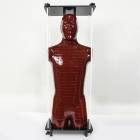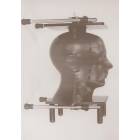RSD Male ART Pelvis (Sections 26-35) with 1.5cm x 1.5cm Hole Grid Spacing
Varies. Please contact Customer Service for availability.
In stock
You May Also Need
Checked products are added to the cart with this item.
-
 RSD Male Breast Attachment with 3cm x 2.5cm Hole Grid Spacing - Volume 1000mlMSRP $490.00 MSRP $490.00 $457.00
RSD Male Breast Attachment with 3cm x 2.5cm Hole Grid Spacing - Volume 1000mlMSRP $490.00 MSRP $490.00 $457.00 -
 RSD Male Breast Attachment with 3cm x 2.5cm Hole Grid Spacing - Volume 1250mlMSRP $530.00 MSRP $530.00 $495.00
RSD Male Breast Attachment with 3cm x 2.5cm Hole Grid Spacing - Volume 1250mlMSRP $530.00 MSRP $530.00 $495.00 -
 RSD Male Breast Attachment with 3cm x 2.5cm Hole Grid Spacing - Volume 250mlMSRP $350.00 MSRP $350.00 $327.00
RSD Male Breast Attachment with 3cm x 2.5cm Hole Grid Spacing - Volume 250mlMSRP $350.00 MSRP $350.00 $327.00 -
 RSD Male Breast Attachment with 3cm x 2.5cm Hole Grid Spacing - Volume 500mlMSRP $390.00 MSRP $390.00 $364.00
RSD Male Breast Attachment with 3cm x 2.5cm Hole Grid Spacing - Volume 500mlMSRP $390.00 MSRP $390.00 $364.00 -
 RSD Male Breast Attachment with 3cm x 2.5 cm Hole Grid Spacing - Volume 750mlMSRP $470.00 MSRP $470.00 $439.00
RSD Male Breast Attachment with 3cm x 2.5 cm Hole Grid Spacing - Volume 750mlMSRP $470.00 MSRP $470.00 $439.00 -
 RSD Male Breast Attachment with 1.5cm x 2.5cm Hole Grid Spacing - Volume 1000mlMSRP $660.00 MSRP $660.00 $616.00
RSD Male Breast Attachment with 1.5cm x 2.5cm Hole Grid Spacing - Volume 1000mlMSRP $660.00 MSRP $660.00 $616.00 -
 RSD Male Breast Attachment with 1.5cm x 2.5cm Hole Grid Spacing - Volume 250mlMSRP $480.00 MSRP $480.00 $448.00
RSD Male Breast Attachment with 1.5cm x 2.5cm Hole Grid Spacing - Volume 250mlMSRP $480.00 MSRP $480.00 $448.00 -
 RSD Male Breast Attachment with 1.5cm x 2.5cm Hole Grid Spacing - Volume 500mlMSRP $540.00 MSRP $540.00 $504.00
RSD Male Breast Attachment with 1.5cm x 2.5cm Hole Grid Spacing - Volume 500mlMSRP $540.00 MSRP $540.00 $504.00 -
 RSD Male Breast Attachment with 1.5cm x 2.5cm Hole Grid Spacing - Volume 750mlMSRP $600.00 MSRP $600.00 $560.00
RSD Male Breast Attachment with 1.5cm x 2.5cm Hole Grid Spacing - Volume 750mlMSRP $600.00 MSRP $600.00 $560.00 -
 RSD Male Breast Attachment with 1.5cm x 2.5cm Hole Grid Spacing - Volume 1250mlMSRP $700.00 MSRP $700.00 $653.00
RSD Male Breast Attachment with 1.5cm x 2.5cm Hole Grid Spacing - Volume 1250mlMSRP $700.00 MSRP $700.00 $653.00
Product Description
Male ART Pelvis (Sections 26-35) with 1.5cm x 1.5cm hole grid spacing; either 5mm or 7mm diameter holes, tissue-equivalent plugs. Internal and external assembly systems.
ART phantoms are molded of tissue-equivalent material; they are designed within highly sophisticated technological constraints and follow ICRU-44 standards. They are also designed for accuracy and ease of use.
Anatomy: The male ART represents a 175 cm (5 ft. 9 in.) tall, 73.5 kg (162 lb.) male. The ART phantom is transected-horizontally into 2.5 cm thick slices. Each slice has holes which are plugged with bone-equivalent, soft-tissue-equivalent or lung tissue equivalent pins which can be replaced by TLD holder pins. The holder pins are ordered separately. Soft-tissue-equivalent coatings produce slices with glass smooth interfaces. These coatings are cut away over the air spaces of the oronasal pharynges, trachea and stem bronchi. Dosimetry holes are drilled in grids 3cm x3 cm or 1.5cm x 1.5cm in 5 and 7 mm diameters. These afford detailed measurements of dose distributions.
Materials
Assembly: ART phantom slices are held between aluminum plates by nylon tie rods. Knobs at the end of the rods clamp the slices tightly in proper alignment. Both internal and external assembly devices are included. The external assembly facilitates film dosimetry, while the internal assembly is used generally with TLDs or ionchamber dosimetry.
ART phantoms are molded of tissue-equivalent material; they are designed within highly sophisticated technological constraints and follow ICRU-44 standards. They are also designed for accuracy and ease of use.
Anatomy: The male ART represents a 175 cm (5 ft. 9 in.) tall, 73.5 kg (162 lb.) male. The ART phantom is transected-horizontally into 2.5 cm thick slices. Each slice has holes which are plugged with bone-equivalent, soft-tissue-equivalent or lung tissue equivalent pins which can be replaced by TLD holder pins. The holder pins are ordered separately. Soft-tissue-equivalent coatings produce slices with glass smooth interfaces. These coatings are cut away over the air spaces of the oronasal pharynges, trachea and stem bronchi. Dosimetry holes are drilled in grids 3cm x3 cm or 1.5cm x 1.5cm in 5 and 7 mm diameters. These afford detailed measurements of dose distributions.
Materials
- Soft Tissues: There are unlimited, small variations in density and absorption throughout the human body. Phantom soft tissue is closely controlled to have the average density of these tissues.
- Skeletons: RSD skeletons are highly-detailed polymer moldings which reproduce the shape, mass density and attenuation coefficients of cortical bone and spongiosa. They allow continuous production of phantoms, instead of the sporadic production required by the limited availability, variable size and uncertain chemical composition of human skeletons. These problems, plus loss of marrows in dried natural skeletons, make RSD skeletons superior to "real bone". Molds for the RSD cortical bone and spongiosa were made from human skeletons consistent with the sizes of the softtissue molds. RSD skeletons conform closely to the standards established by the International Commission on Radiation Units and Measurements (ICRU Report No. 44); mass density is reduced slightly to take into account a small decrease in calcium content for older patients.
Assembly: ART phantom slices are held between aluminum plates by nylon tie rods. Knobs at the end of the rods clamp the slices tightly in proper alignment. Both internal and external assembly devices are included. The external assembly facilitates film dosimetry, while the internal assembly is used generally with TLDs or ionchamber dosimetry.
About this Brand

After developing the first anthropomorphic test dummy for the aviation industry in the late 1940's, the RSD team directed its impactful R & D to revolutionize healthcare diagnostic imaging with anthropomorphic phantoms. RSD diagnostic imaging phantoms are routinely used to perform quality control on imaging equipment and to train healthcare professionals in best practices. The company has become the leading supplier of QC and educational solutions for medical diagnostics and radiation therapy, featuring products such as anthropomorphic phantoms and dosimetry verification phantoms.
Specifications
| Manufacturer | RSD |
|---|---|
| Item Ships From | California |
Returns
This item is not able to be returned.
Reviews
Write Your Own Review
Only registered users can write reviews. Please Sign in or create an account
Ask a Question
Customer Questions
This product has no questions.
Did you find what you were looking for?
You May Also Like







